Controlling Page Background Color
To specify a page background color for your document, choose Layout | Page Background (CTRL+J) to open the Options dialog to the Background page.
Solid
Choose this option and a color from the selector to specify any uniform
color as the page background. Click Other in the color selector to use a
color picker in different color models (RGB, CMYK, and so on), a mixer,
or a specific color palette. Once a color has been chosen, the page
background is set to that color, but the bleed area and the workspace
are not. Bitmap
Choose this option to use a bitmap as the page background. Click the
Browse button to open the CorelDRAW Import dialog, and locate and choose
a bitmap. Background bitmaps are tiled as many times as needed to fill
the page. You can also scale the number of repeating tiles by clicking
the Custom Size radio button and entering values. The best bitmaps to
use for patterns are ones that have been designed to tile seamlessly. In
Figure 3,
you can see an application of a Background Bitmap that is muted in tone
(and therefore is suitable for white headline text) and that was
designed to seamlessly repeat. The Bitmap option is terrific for
creating several different signs or stationery that contain different
text but must be tied together in a theme. You might, for example,
create different text on layers such as “Swimsuit Sale,” “Vacation
Sale,” and “Inflatable Theme Toy Sale,” and then print different signs
by hiding all but one layer for printing. You can’t accidentally move
the Background, and this technique is quick to set up when you have 12
different messages that need a common background.
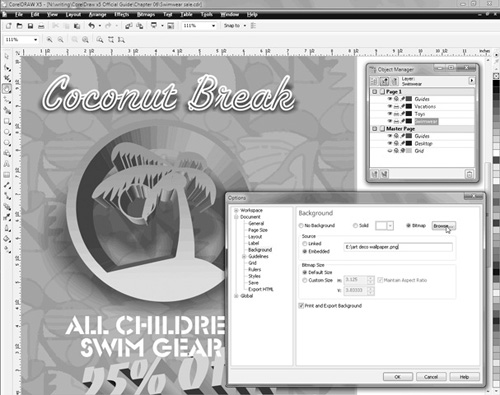
Source The
Source options let you establish an external link to the bitmap file or
store a copy of it internally with your CorelDRAW X5 document file.
Choose Linked to maintain an external link or Embedded to store the
bitmap with your document. While Linked is selected, the file path to
the bitmap is displayed, and the bitmap itself must be available to
CorelDRAW during printing. This option is very useful when you need to
conserve on saved CorelDRAW file sizes; additionally, you can modify the
background bitmap in PHOTO-PAINT or Painter, and then reload the edited
bitmap in the future. Bitmap Size This
field contains “either/or” radio buttons. If you choose Default Size,
the background appears on the page because the bitmap’s original
dimensions allow it to tile as many times as needed to fill the page.
However, if you want a smaller bitmap as the background (more tiles),
click the Custom Size button. The Maintain Aspect Ratio option is
checked by default; you probably don’t want the bitmap background to
look smooshed or stretched—with Maintain Aspect Ratio turned on, all you
need to do is enter one value in either the H or V field, and CorelDRAW
automatically fills in the remaining field. Note that bitmaps are
resolution dependent, unlike vector drawings. Thus, you can usually
scale down a bitmap, but don’t try to enlarge it, because the bitmap
will go through something called resampling, and blurriness is often the
result. Scale down = yes; scale up = no. Print And Export Background Use
this option to control whether the page background you’ve added to your
document page is included when exporting your drawing files or when you
print the document. It’s available when either Solid or Bitmap is
selected for the page background; by default, it’s active.
Using Layouts and Labels
The property bar is used to set
up the basic page and paper sizes and orientation. But designers often
need to lay out designs for items such as labels, booklets, tent cards,
and greeting cards that are printed on standard size paper, but that are
definitely not
laid out like a single-page flyer. So you don’t have to sit at your
workstation all day folding paper to try to figure out exactly where the
fold lines are and where the text needs to be upside down. CorelDRAW X5
provides specialized layouts that are just a few clicks away. These
timesavers are not on the property bar—you need to open the Options
dialog to choose the one you want from the Layout drop-down box.
Choosing Specialized Layouts
On the Layout page of the
Options dialog, you can choose from seven specialized layouts for your
document including Full Page, Book, Booklet, Tent Card, Side-Fold Card,
Top-Fold Card, and Tri-Fold Brochure.
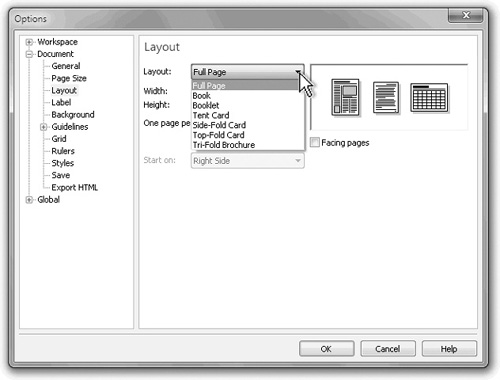
Choosing
one of these layout styles instantly divides the current document page
size into horizontal and vertical pages, based on the preview supplied
in the dialog.
Full Page This layout style is the default for all new documents, and it formats your document in single pages, like those shown here.
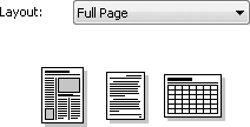
Book
The Book layout format, shown right, divides your document page size
into two equal vertical portions, and each portion is considered a
separate page. When printed, each page is output as a separate page.
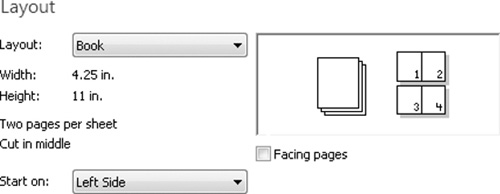
Booklet
In a similar arrangement to the Book layout, the Booklet layout format
divides your document page size into two equal vertical portions. Each
portion is considered a separate page. However, when printed, pages are
paired according to typical imposition formatting, where pages are
matched according to their final position in the booklet layout. In a
four-page booklet, this means page 1 is matched with page 4, and page 2
is matched with page 3, as shown at right.

Tent Card The
Tent Card layout format, shown at right, divides your document page
size into two equal horizontal portions, each of which is considered a
separate page. Because tent card output is folded in the center, each of
your document pages is printed in sequence and positioned to appear
upright after folding.

Side-Fold Card
The Side-Fold layout format divides your document page size into four
equal parts, vertically and horizontally. When printed, each document
page is printed in sequence, and positioned and rotated to fit the final
folded layout. Folding the printed page vertically, then horizontally,
results in the correct sequence and orientation.
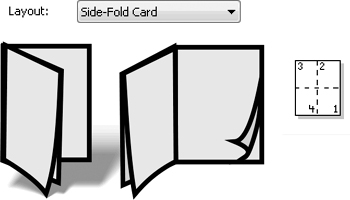
Top-Fold Card
Like the Side-Fold layout, the Top-Fold layout format also divides your
document page size into four equal parts, vertically and horizontally.
When printed, each document page is printed in sequence, and positioned
and rotated to fit the final folded layout.
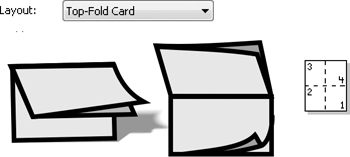
Tri-Fold Brochure Set
your page orientation to Landscape using File | Print Setup, and you
then have the ideal layout for travel brochures and restaurant tabletop
stand-up menus. If your printer supports it, you can print both sides
for a total of six panels, with live space measuring about 3 ½″ wide and
8″ high on the end panels.
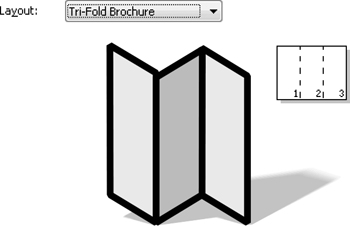
After you choose a layout
style and return to your document, each subdivision of the layout can be
viewed individually. You can also view pages in pairs by choosing the
Facing Pages option in the Layout page of the Options dialog for several
layout styles. When Facing Pages is selected in the dialog, you also
have the opportunity to start your document on either the Left Side or
Right Side for some layout styles by making a selection from the Start
On menu.
Using Preformatted Labels
CorelDRAW has a
comprehensive collection of label formats for preformatted paper stock
from vendors such as Avery, Ace, and Leitz. Once you’ve clicked the
Labels radio button, the Page Size page turns into the Label page,
offering access to the label collection. After you’ve selected a
specific label format, the preview window shows its general layout and
indicates the number of rows and columns available, as shown in Figure 4.
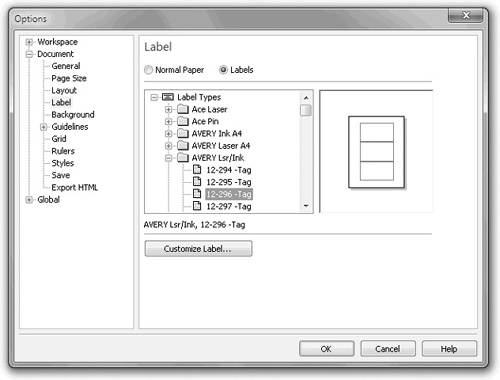
After you choose a label
format and return to your document, each of your document pages will
represent an individual label. You’ll need to add the exact number of
pages to accommodate all of your labels. If you don’t see the exact
manufacturer for your specific label type, you can create your own from
scratch, or base it on an existing label format (see Figure 5).
Choose an existing label from the Label Types menu; click Customize
Label; set the number of Rows and Columns; and set the Label Size,
Margins, and Gutters according to your own label sheet. Once the format
is created, you may save your label by clicking the plus (+)
button next to the Label Style drop-down list. You can delete a
selected label format from the list by clicking the minus (–) button.
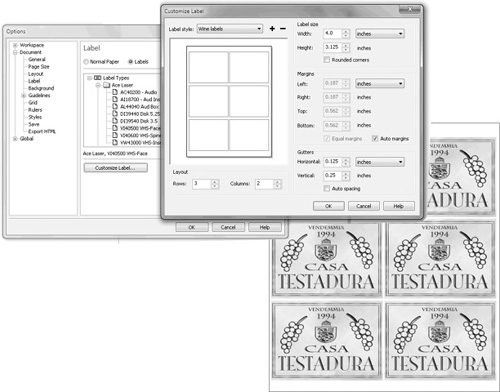
|